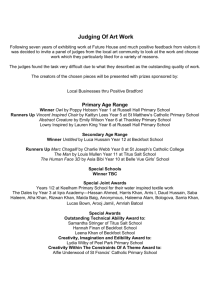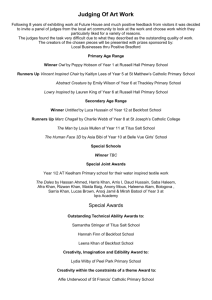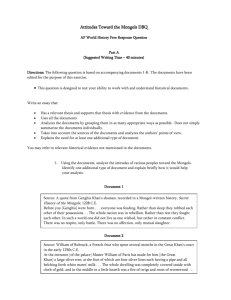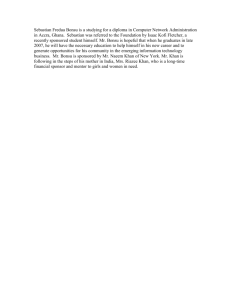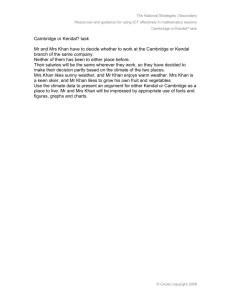Are We Asking the Right Questions?
advertisement
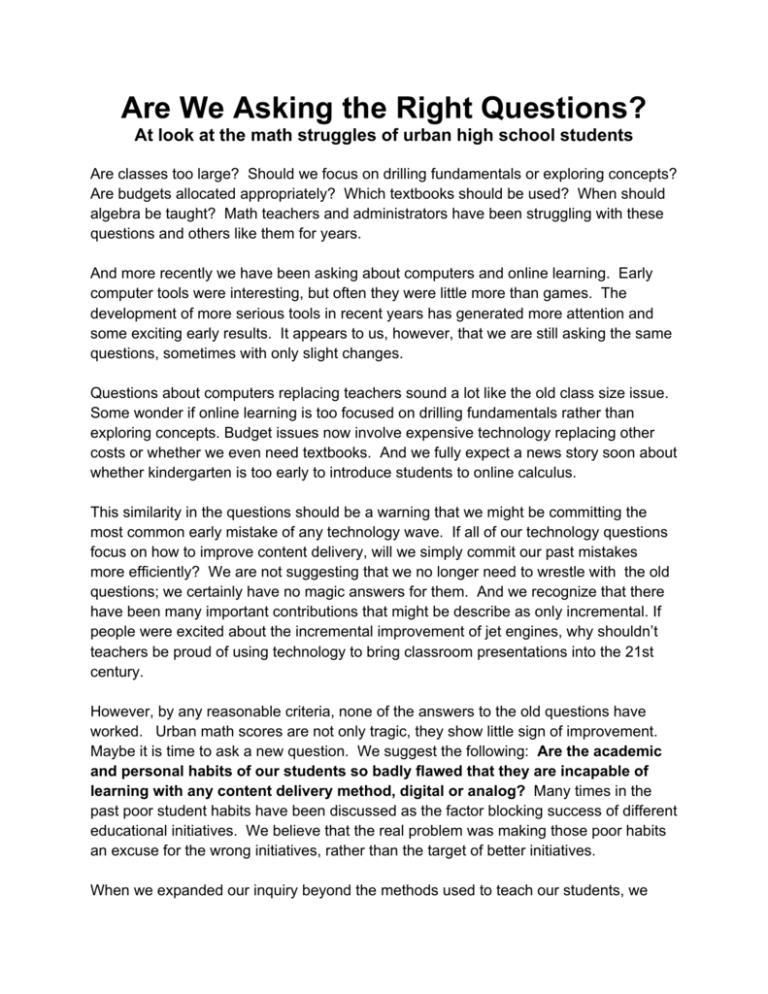
Are We Asking the Right Questions? At look at the math struggles of urban high school students Are classes too large? Should we focus on drilling fundamentals or exploring concepts? Are budgets allocated appropriately? Which textbooks should be used? When should algebra be taught? Math teachers and administrators have been struggling with these questions and others like them for years. And more recently we have been asking about computers and online learning. Early computer tools were interesting, but often they were little more than games. The development of more serious tools in recent years has generated more attention and some exciting early results. It appears to us, however, that we are still asking the same questions, sometimes with only slight changes. Questions about computers replacing teachers sound a lot like the old class size issue. Some wonder if online learning is too focused on drilling fundamentals rather than exploring concepts. Budget issues now involve expensive technology replacing other costs or whether we even need textbooks. And we fully expect a news story soon about whether kindergarten is too early to introduce students to online calculus. This similarity in the questions should be a warning that we might be committing the most common early mistake of any technology wave. If all of our technology questions focus on how to improve content delivery, will we simply commit our past mistakes more efficiently? We are not suggesting that we no longer need to wrestle with the old questions; we certainly have no magic answers for them. And we recognize that there have been many important contributions that might be describe as only incremental. If people were excited about the incremental improvement of jet engines, why shouldn’t teachers be proud of using technology to bring classroom presentations into the 21st century. However, by any reasonable criteria, none of the answers to the old questions have worked. Urban math scores are not only tragic, they show little sign of improvement. Maybe it is time to ask a new question. We suggest the following: Are the academic and personal habits of our students so badly flawed that they are incapable of learning with any content delivery method, digital or analog? Many times in the past poor student habits have been discussed as the factor blocking success of different educational initiatives. We believe that the real problem was making those poor habits an excuse for the wrong initiatives, rather than the target of better initiatives. When we expanded our inquiry beyond the methods used to teach our students, we realized that we needed to take a closer look at those students, and whether they had the necessary academic and personal habits that would allow them to learn that content. Content gaps and our techniques for content delivery mean nothing if we cannot improve the habits of the students receiving that content. If you have spent time in an urban classroom, you can imagine our anxiety at the prospect of changing the habits of our students. The bright side of this new task, however, was that it made the conversion to online learning seem comparably easy. When we stopped worrying about whether Khan videos were better than our own lectures, or whether Khan exercises had the appropriate mix of concept vs. drill, we recognized that we had found a powerful tool that reaches students and changes their habits in ways we had never even considered possible. We are making the conversion to online learning in the math classroom and we have been using Khan. Our kids are still struggling, some much more than others. So we make no claim to having found the answers. But the encouraging early results that we have achieved suggest that we may finally be wrestling with the right question. Overview of our school Oakland Unity High School is a four-year (9-12) public charter high school located in the tough urban neighborhood of East Oakland. Approximately 95% of our students are Latino or African-American and 85% receive free or reduced lunch. More than 90% of our students go on to college, 70% to a four-year college, and 90% will be the first in their families to attend college. By most measures we have had great success. Our API (Academic Performance Index) has grown steadily since 2007, from 595 to 735 this past year. Nearly 90% of our students regularly pass the CAHSEE (Mathematics) in their sophomore year, with 70% of them scoring at or above the proficient level of 380. By these traditional measures we are the highest preforming four-year (9-12) public high school in Oakland. Several other schools are higher performing, but they have the advantage of starting with their students in middle school or even elementary school. Nearly 85% of our incoming freshmen attended Oakland public schools. A deeper look reveals a problem A deeper look at the data, however, suggests that our students have actually had too little success in learning math. Our students take the EAP (Early Assessment Program) Math Assessment in their 11th grade year. In 2011, less than 5% our students tested as “Ready for College.” And on last year’s California Standards Test (CST) in Algebra 1, less than 30% of our students scored at the proficient level. The sad fact is that this CST result was a significant improvement for us, and many urban schools would be pleased with this score. A realistic appraisal of this result, however, must start with the fact that a score of only 60% is considered “Proficient” on the CST exam. Honestly, this was a low result against a very low bar. And yet we have been doing all of the “right” things. We are an independent charter school with a phenomenal staff of accredited and dedicated teachers. Our students are monitored and nurtured with a system that includes one teacher that serves as an advisor all four years, two full time administrators for only 255 students and frequent parent/teacher meetings. We have high average daily attendance (97%) and a well disciplined school environment that includes uniforms and “no cell phones” policy that is enforced by confiscating them until June. We realized that we needed to analyze the math struggles of our students and identify the root causes of our low results. Looking for the root causes The most obvious problem we found was that students enter our school with a knowledge gap. We test incoming student with a short version of an algebra final exam, and the average score for the past two years has been 15%. Both years. This was an important wake-up call for us. Most of these students had already taken algebra in eighth grade, and many of them received A’s and B’s, yet they obviously knew very little algebra. We also tested them on basic arithmetic, with an average score of about 60%. Although this was a better result, it was only simple arithmetic, and many students demonstrated little knowledge of fraction or negative numbers. Based on these results, most of our incoming freshmen now retake algebra with us, with a heavy emphasis on fractions and negative numbers in that class. If the knowledge gap were the only problem, this back-to-basics approach, combined with our well structured school program, would have been the easy solution. We did see positive results. Our math CST scores did improve over prior years. In addition to our increased level of proficient students, the portion of freshmen students scoring in the below basic and far below basic (a score of 40% or below) dropped from 73% to 23%. But again, this is a low result against a very low bar. Filling the knowledge gap was only part of the problem. We needed to look deeper for the root cause of our students’ math struggles. We started by simply asking our students why they were struggling. Many explanations were offered, mostly summarized as they had a bad teacher. As we probed on this belief, reminding them that they had only been in our school for a few months but had struggled in math for many years, many recounted stories of past bad teachers, or missing teachers replaced by a string of substitutes. Our many private discussions with students suggested another rationalization, and we shared it with them. Many students said that they struggled in math because they believed that they were not good in math, or more sadly, that they were not smart. It appeared that for many students, whenever they looked at a difficult math problem, their first reaction was that is was more evidence that they had a bad teacher. Or it was more evidence that they were not smart. If they had a good teacher, or if they were smart, then they would be able to do the problem. Because such strong beliefs were triggered whenever they looked at a difficult math problem, their natural reaction was to simply give-up. We were surprised by how many students agreed that this was an accurate description of their reactions to math problems. The clearly psychological nature of this reaction suggested that we needed to look at the attitude characteristics of our students. Looking at the habits of our students Ideally, we would like to see several characteristics, or habits, in our students: ● Confidence ● Effort ● Responsibility We would like our students to have a reasonably confident outlook, a basic faith that they can succeed in math if they apply themselves. We would like them to make an effort, to have the habit of working hard. And we would like them to take responsibility for their education, to have the habits of paying attention in class and seeking help when they need it. We do not expect perfection from our students in their habits; after all, they are teenagers. But our students presented significant issues in these areas. And once we started looking at our results in the context of these habits we began to see evidence everywhere that our students’ habits were a much more serious problem than the knowledge gap. As we continued to think about these habits, and as we discussed this problem with our students, an informative but tragic story emerged. Some time in elementary school many of these students ran into trouble in math. The first problem was often long division, then fractions and later negative numbers. Word problems joined the list along the way. These were not problems with quick fixes. Many of the students really did not understand these topics, and the knowledge gap was born. Day after day, they looked at math problems and were not able to do them. Repeated failure and constant frustration became a way of life. As this knowledge gap persisted for many years, along with the related failure and frustration, the students lost their confidence and developed the habit of thinking negatively about themselves. As they looked at their math homework every night, their habitual negative thoughts made it seem reasonable to quit. They had a rationalization for being unable to do their math and quickly lost the habit of hard work, replacing it with the habit of laziness. As time went on, some students broke out of this cycle, rescued by terrific teachers or parental guidance. But many continued to struggle, and their bad habits only became more entrenched. These failing students needed to find a way to cope and survive. Some cheated. Or well-intentioned teachers let them improve their grades with extra credit work. Many were simply passed on to the next grade. The unfortunate truth is that there were few consequences for not knowing and not doing. After years of getting by in school with little effort, and even earning good grades, it is not surprising that many students lost any sense of responsibility for their learning. If this were extent of the problem, it would be bad enough. But unfortunately there is one more wrinkle in this journey of struggle. Students developed a sense of familiarity with topics such as fractions because so many teachers had tried to teach it to them over the years. However, this familiarity did not extend deep enough to become real knowledge because the students had not done the necessary practice (homework) to really learn the topics. This familiarity, combined with the fact that these students had been allowed to succeed despite negligible effort or results, created a sense of false confidence. Now, these students not only do not know, they do not know that they do not know. When these students enter our algebra classroom we are facing a serious challenge. They have a significant knowledge gap, but they refuse to listen as we try to fill that gap because of their false confidence. With their poor work habits it is difficult for them to learn any new topics, so the knowledge gap continues to grow. And because of their general lack of responsibility for their own learning, it is difficult to engage them in any meaningful discussion about any of this. Finding a Solution to the Homework Problem As mentioned above, we had made progress, but not nearly enough. One clear observation was that much of the improvement we had achieved had resulted from improvements in basic skills such as fractions and negative numbers. This partly reflected the obvious fact that many algebra equations included these components. Less obvious was the impression that student confidence in their math ability seemed to increase as their confusion in these difficult areas decreased. Another clear observation was that those improvements in skills were directly attributable to increased practice of those skills, primarily through homework. Unfortunately, students were not doing as much homework as we wanted. They had made significant improvements over prior years, but it was still not enough. And even more troubling, we began to see a variety negative behaviors by the students to avoid homework. Many copied their homework. Others gave up too easily and came in after school asking for help. It was clear, however, that many did not want help in understanding how to do the problems. What they wanted was for someone to do the problems on the board so they could copy them onto their paper. We had tried many different approaches to increase homework, and we feared that we had reached a limit of homework compliance. In desperation to find some way to increase practice time we decided to try Khan. Khan is well known for a large video library, but we were more interested in its more than 300 sets of math exercises. These exercises range from simple arithmetic through calculus, with the majority in the prealgebra and algebra range. This is the wrong place for a full Khan description, but the features we were most interested in were these: ● Problems are randomly generated, so students cannot copy work from another student. ● Problems are not multiple choice, so students need to do the work rather than guess. ● Students have immediate access to help in the form of brief videos or detailed explanations of the steps to complete a problem ● A variety of subtle design features make the experience interesting (and almost fun) for the students. ● The individualized nature of the system gives students more flexibility to work at their own pace. ● Many management reports let us track student efforts We introduced Khan to our students on the belief that the above features would increase practice time in school and at home. We achieved this result. Much to our pleasant surprise, however, Khan delivered another benefit as well. Using online learning to address student habits The combination of the design features of the Khan system and a very creative set of problems has produced a very significant effect on the habits our students. A specific example will help explain this. The following two “screen shots” from the Khan system present an example of a number line problem and the teacher’s screen that summarizes one student’s activity on that group of problems. One student’s effort on the above problem group: The above problem really is as simple as it looks. The orange dot is 3 positions to the right of – 9, so its value is – 6. Two positions back to the left is – 8. The fact that this problems is very challenging for many of our students is a clear illustration of their poor habits. We do not believe that a student struggles on this problem because of a knowledge gap. What knowledge exactly is required? Our students might struggle with multiplying or adding negative numbers, but they do know how to count, even in the negative range. Even more telling, students struggle on this group of problems even when the numbers are all positive! Observing students struggle with these problems suggests a simpler explanation. Students take a quick glance at this problem and then make careless calculations. They see the numbers 9 and 2, ignore the negative sign, and rapidly enter 11 (9+2). When that is marked incorrect they rapidly enter 7 (9–2). When that does not work they try –11 and – 7 in rapid succession. In the time it takes to enter these hasty guesses they could have simply done a little counting on the number line and found the correct answer. They lack confidence in their ability to solve a problem as simple as this, and they have lost the habit of mental effort. So even several seconds of counting out a solution is just too much for them. They take no responsibility for resolving this problem; they are not determined to figure this out. Interestingly, despite their lack of responsibility, some part of them recognizes the simplicity of this problem. And this challenge to their false sense of confidence makes them frustrated and angry. I am frequently called over by a student working on such problems who wants to complain that the computer is wrong! A student who reacts this way to such a simple problem is not ready to learn algebra; he does not have the necessary habits. The next screen summarizes one student’s effort on problems such as the one shown. Each vertical bar represents one problem from this category of exercises. The height of the bar is the length of time spent on each problem. The camera icon on the first bar indicates that this student chose to watch a video after starting the first problem. The question marks indicate that the student asked for hints – detailed steps for solving that problem. Looking at this screen you can “see” the student confront his false confidence, recognizing the fact that he does not know how to do the problem. He must take responsibility for his learning, using the videos and hints on the system or seeking help from the teacher or one of the other students. And he puts in real effort, completing 35 of these problems, many of them correctly. This is a clear example of a student “repairing” the bad habits that were preventing his learning. We believe that this approach is resulting in a fundamental change in student character – with responsibility replacing apathy and effort replacing laziness. We believe that this character change is the primary reason behind the stunning results we are beginning to experience. Year-to-year improvements in test results We give the same tests to our students each year. The following two charts looks at the results of 5 of those tests, and compares results between this year's freshmen and last year. The five tests were ● Summer pre-assessment in algebra. ● October test on solving linear equations ● December test on absolute value equations and inequalities. ● January final exam for the 1st semester. ● February test on systems of equations. Both groups of freshmen scored poorly n the summer pre-assessment, with mean scores of 16%. This year’s freshmen had mean scores higher by 10 to 12 percentage points on the next three test. This was a very satisfying result, especially when you consider that a 12 percentage point difference on means of only 50% to 60% is an improvement of more than 20%. And the increase in the mean was nearly 40 percentage points for the recent test on Systems of Equations. We doubled last year’s mean! The results are even more dramatic when we focus on the percentage of students with scores higher than 80%. Neither class had any students in this range on the pre-assessment. Last year’s class had 30% of the students above 80% on the linear equation test. However, after this relatively easy topic (linear equations is essentially a pre-algerba topic) the number of students scoring above 80% dropped significantly, with only 5% of the class above this level on the very difficult test on systems of equations. This year’s class has had significantly better results, with 40 to 50% of the students scoring above 80% on each of the tests. Analyzing the source of the improvement In order to better understand the the strong results among this year’s freshmen, we analyzed the most recent test on systems of equations. We separated the individual scores on that test into four groups, based on the relative effort of students on their written homework and on their Khan exercises during the two and one-half weeks we spent on this chapter. The results are summarized in the four-box diagram below. The 12 students in the lower left box had grades of less than 50% on their written homework and completed 4 or fewer Khan exercises. The mean test score for this low effort group was 46%. The 2 students in the upper left box had Homework grades between 50% and 100%, but had completed the same number of Khan exercises, 4 or fewer. Their mean test score was the same 46%. The 5 students in the lower right box had homework scores of 50% or less, but this group completed 5 or more Khan exercises. Their mean test score was 84%. The 18 students in the upper right box had homework scores above 50% and completed 5 or more Khan exercises. The mean test score of this high effort group was 92%. ] We use this four-box method to identify the impact of written homework and Khan exercises on test scores. The two lower boxes of low homework effort had an mean test score of 65%. The two upper boxes of high homework effort had an mean test score of 69%. The increased homework effort of the students in the top two boxes changed the average test score by only four percentage points. The two left boxes of low Khan effort had a mean test score of 46%. The two right boxes of high Khan effort had a mean test score of 88%. The increased Khan effort of the two right boxes changed the mean test score by 42%. This got our attention! One obvious question is the direction of the causality. Did more Khan improve the ability of students to solve these problems? Or were students with more ability better able to complete Khan exercises? It is possible that there is at least some dual effect at work here, but consider these two statistics: ● This class of freshmen had the same algebra pre-assessment score as last years class. ● The mean score of the 12 students in the lower left (low effort) box of this year’s class was about 10 percentage points higher than the mean for the entire group of last years class. Both classes started in the same place, with a significant math knowledge gap, but eight months later the bottom of this year’s class is above the average for the entire last year’s class. We believe that changes in habits are the reason for this improvement. And we think Khan played an important in changing those habits. Even the “low effort” group in this year’s class spends significant time working on Khan. And that Khan exposure seems to have helped generate a sense of responsibility in our students and encouraged much more effort. Individual student story The chart below relates to one of our freshman algebra students. This student failed every quiz first semester, every test except the first test on pre-algebra topics and the first semester final exam. This is a screen shot of the student’s activity in Khan from January 10 through February 20. It shows many days of significant time completing exercises or watching videos, some of that time in class, but much of it at home. This effort was a sharp increase over his first semester work on Khan. When asked about this he said he simply decided to start working harder. He watched video for both algebra and biology and did lots of algebra exercises. This new sense of responsibility and the burst of effort resulted in a major breakthrough for this student on the February test on systems of equations. This was a very difficult test. Remember, last year the class average was 37%, and this year’s class average was 74%. His score was 92%. A week later he got an 87% score on a quiz on exponents, one of the highest scores in the class. Wow! “A journey of a 1,000 miles begins with a single step.” The sample size is small, we have less than one year’s results and it is always difficult to isolate the cause of changes in topics involving human psychology. But, we think we have taken that first step. It feels right. That first step was finding the right question, and that question is all about fixing the habits of our students. This realization led us to Khan and Khan was an important factor in generating our encouraging results. However, we really believe that the introduction Khan by itself would not have resulted in the level of success were are beginning to achieve. If we had not started with the intent to improve the habits of our students, we would not have run a four week summer program for incoming freshmen. This program started the process of getting our new students to focus on the classroom attention and effort while we started the process of working on basic skills in math (and English as well.) Additionally, if we had not realized that Khan’s primary importance was its effect on the habits of our students, we might have reacted very differently throughout the year when we encountered periods of reduced Khan activity. We quickly “named” the issue for the students, stressing the need for them to take responsibility, and to make a habit of completing their work. And we introduced simple consequences for not completing their Khan work, such as sharp reductions in their grades and the requirement to time after school working on Khan. Perhaps more importantly, we did not allow any early student struggles with Khan to create doubts about the program. The fact that students often struggled with some of the Khan problems was not proof that Khan did a poor job of content delivery. Rather, the fact that students were actually struggling was proof that they were finally taking their education seriously enough to care about solving a problem. Contact us: Oakland Unity High School 6038 Brann Street Oakland, CA 94605 David Castillo, Principal mrdavidcastillo@gmail.com Peter McIntosh, Math Teacher peterjmcintosh@gmail.com Kallie Berg, Math Teacher kalamazoo25gmail.com
